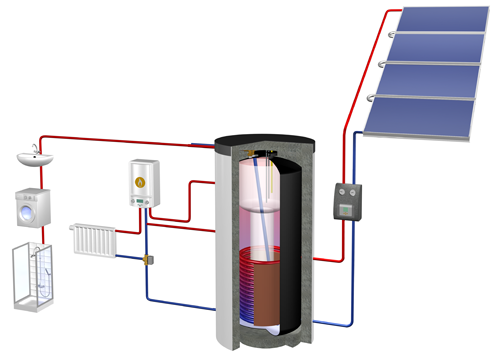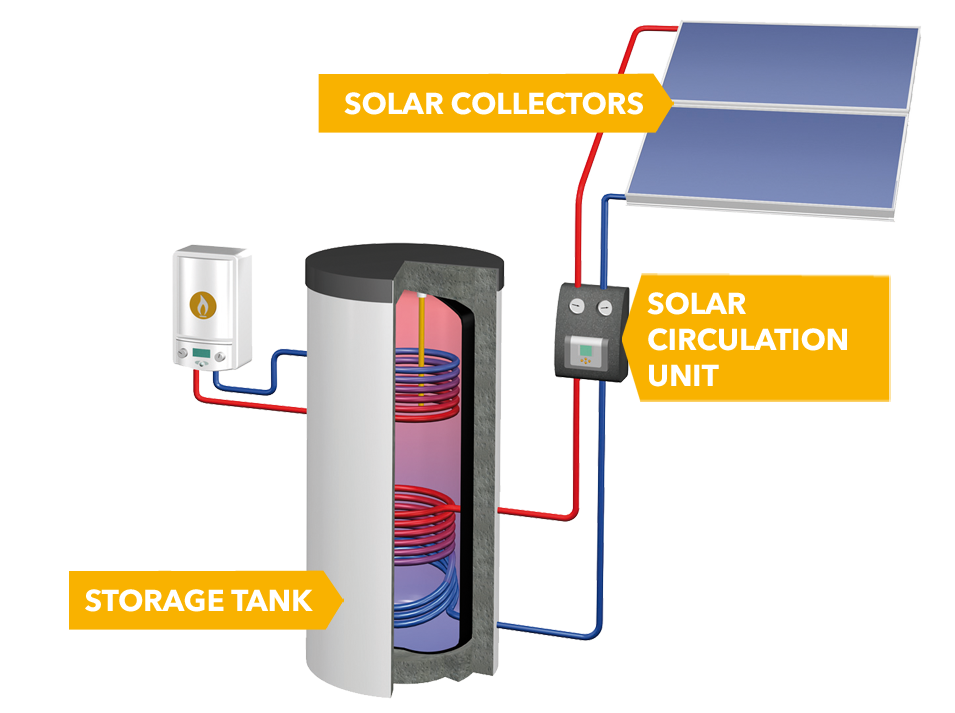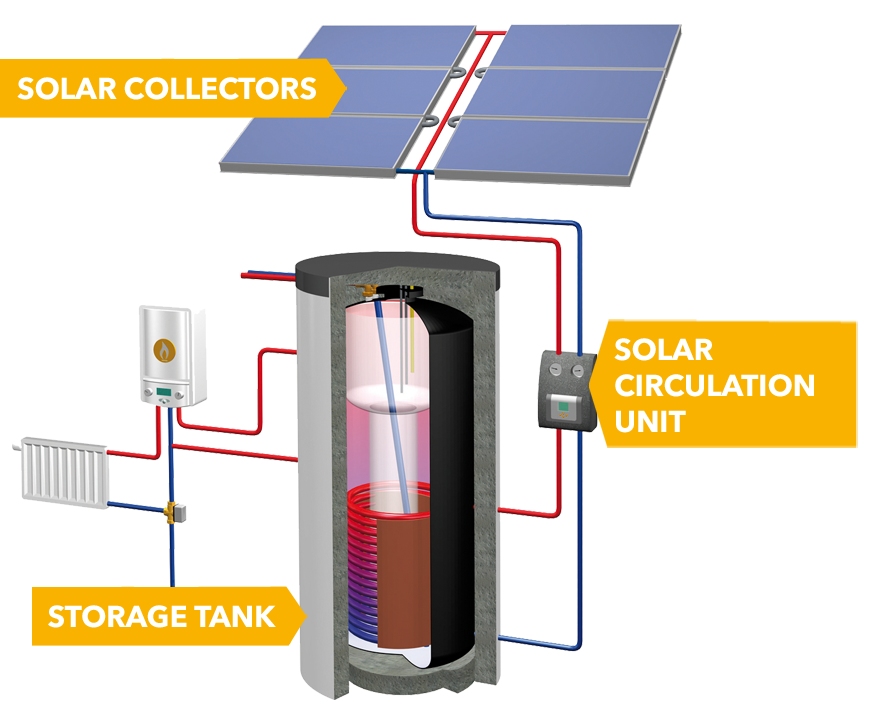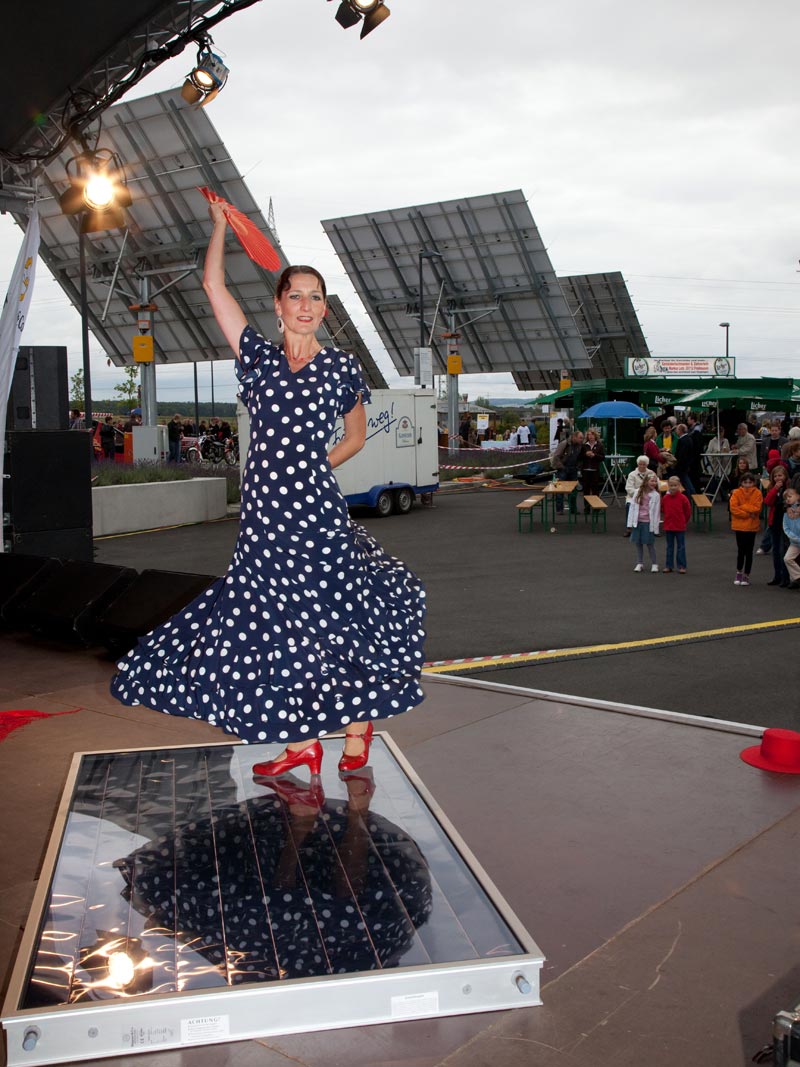FAQ – Frequently Asked Questions about Solar Heat (Solar Thermal)
What is the difference between solar thermal energy (solar heat) and photovoltaics (solar power)?
Solar thermal systems, commonly referred to as solar heat, convert solar energy to heat by means of solar collectors. Their functional principle is based upon the absorption of short wave radiation and its conversion to heat.
The heat generated usually is used entirely in your own house or business to produce hot water and/or to support the central heating system or for commercial applications.

Photovoltaics, commonly referred to as solar power, directly converts solar radiation energy to electrical energy by means of solar cells. The function is based upon the photoelectric effect.
The generated electricity is either fed completely into the public power grid, and the solar power system’s owner receives remuneration within the respective Feed-In-Tariff (FIT) framework of the plant’s location, or a varying fraction of the electric energy is utilized in the own household or business. In the latter case only unused excess electricity is fed into the grid and sold. Thanks to modern storage technologies, the generated solar power can also be temporarily stored, allowing the use of scalable fractions of the solar power independent of the weather and time of day.

How does solar thermal energy work?

Solar thermal - the most direct way to clean energy
Solar thermal systems (solar heat) employ the economical and environmentally friendly direct conversion of solar radiation into heat energy. Their core components are usually roof mounted solar collectors that generate heat by converting short wave solar radiation to thermal energy for space heating or hot water production. With conversion efficiencies of up to almost 98%, solar thermal systems are by far the most efficient method to utilize solar energy to, for example, significantly reduce oil or gas consumption in homes and industrial settings.
The heat generated this way is transferred via pipes to a heat exchanger integrated in a hot water storage tank. The heat exchanger heats the water in the storage tank with solar energy. A sufficiently large and well insulated storage tank can provide sufficient hot water for several days. The heated water can be utilized day and night in kitchen, bathroom and also for space heating.
The yield of a solar thermal system depends decisively on the performance of the solar collectors. Wagner Solar has developed solar collectors ranking among the top performers in Europe and that bear the Solar Keymark label.
The absorber coating of Wagner solar collectors
A simple black lacquered absorber loses approx. 88% of the captured solar heat through long-wave back radiation. Wagner solar collectors brought this figure down to only 5%!
Special glass of Wagner solar collectors
Glass covers made of high transmissivity glass, some with Nano technological surface refinement, allow up to 96% of the solar radiation into the solar collector.
How does a domestic hot water (DHW) system work?

Our solar collectors convert solar radiation to heat. The solar circulation unit transports the heat from the solar collectors to the solar storage tank. The solar storage tank ensures that heat is stored - and can be called up on demand as required. During the heating period, the solar thermal system also contributes to the production of hot water, so that over the year up to between 60 and 70% of the energy required for hot water production comes from the sun.
How does a solar space heating system work?

Solar collectors convert short wave solar radiation to heat. The solar circulation unit transports the heat from the solar collectors to the solar storage tank. If sufficiently high temperatures are available due to the solar radiation, your heating system will be supplied with water from the solar storage tank as required, for example by means of “return flow boost”, i.e. raising the return temperature of the heating circuit. As a result, the central heating system needs less ¬– and sometimes even no – fuel to reach the required heating temperature.
What is solar yield?
And why is solar yield so important?
The heat generated by the solar collectors is stored in a sufficiently large and well insulated water tank. The hot water is then drawn from the hot water tank as required. The solar yield is the amount of solar energy generated which, minus the energy losses, can actually be utilized as heat in the household, be it in the form of domestic hot water or heat for space heating or other purposes.
In a typical detached house, a solar yield of 25 to 30 percent is realistic.
Why is a high solar yield important?
Every solar system owner wants his system to offer the best possible price-performance ratio. But what does this mean?
Let us first look at the fixed costs block.
This includes the costs for basic system components such as storage tanks, piping, controllers, wiring, accessories and also planning and installation. After all, these costs account for approximately 65% of the asset value.
The variable costs
However, the variable part that supplies the energy, comprises the solar collectors. It depends on the collector area and the performance of the solar collectors. Optimum results are achieved with moderate area designs and high quality solar collectors that also generate high yields even in low-radiation months and during overcast weather situations.
What is the new annual collector yield (CAO) for Europe?
The "CAO"(collector annual output) is based on a simple calculation program called "Sceno-Calc". The procedure is defined in the Solar Keymark certification rules and thus standardized throughout Europe. The energy yield is determined at certain locations in Europe, such as Würzburg, Stockholm and Athens, as well as for different working temperatures. The usual location for Germany is, for example, Würzburg, at an operating temperature of 50°C.
In the test certificates for solar collectors, these values are initially stated in kWh/a in relation to the collector. However, the value can only be compared with other collectors if it is converted as to a standardized value, i.e. to kWh/m²a. Previously the conversion has been based on the collector aperture area (the collecting area) as standardized according to EN12975.
A market overview of the current solar collectors with the new CAO value (not all manufacturers publish this value) can for example be found in the issue of the German renewable energy industry magazine SONNE WIND & WÄRME (SUN Wind and ENERGY) vol. 10/2013.
How much of the energy costs does a solar thermal system save?
In central and western Europe, approximately 60 percent of net energy costs for domestic hot water production can generally be saved. With top quality solar collectors and low-loss heat storage tanks, even up to 70 percent are realistic
With respect to a space heating supporting systems, oil or gas consumption for an average single-family home can be reduced by up to 30 percent or more.
How much hot water does a solar thermal system supply?
In central and western Europe, a solar thermal domestic water heating system with a collector surface of approx. 5 m² supplies enough energy for an average of 200 liters of hot water per day. On very sunny days hot water production in excess of 400 liters is possible.
Does solar thermal energy only work in sunshine?
High-quality solar collectors still deliver significant energy yields even under a misty and cloudy sky when the solar disc is no longer visible. This is especially the case for solar collectors equipped with high-quality anti-reflective glass. These high-end collectors can also absorb significantly more solar radiation energy during times of slanted light incidence in the course of the day.
Where can solar collectors be installed?
MWith a flexible and well thought out mounting system, the solar collectors can be mounted almost anywhere to best capture the sunlight. Basically, the collectors can be set up on any roof.
On pitched roofs, installation is either directly on the roof or as in-roof or roof integrated installation. With in-roof installation, the collectors are attached directly to the roof construction and replace the roof for this area. The collectors then are flush with the roofing. Solar collectors can also well be mounted to the house façade and integrated into the building envelope in an architecturally appealing manner.
For flat roofs or roofs with a flat slope of less than approx. 15°, a free-standing installation is the solution of choice. With the Wagner Solar Tric-F mounting system for free-standing installations, the installation angle of the collectors can be adjusted steplessly. As a rule, 40° to 55° are recommended for central Europe.
What roof orientation should my roof have?
In order to capture most sunshine, the roof surface should be aligned between southeast and southwest and have an angle of inclination between 20° and 60°.
However, with excellent solar collectors, such as our powerful EURO solar collector range, as well as with a larger collector area, an east or west roof is also suitable to achieve sufficient solar yield. It should be noted that shading of the roof area by other houses, structures or trees is always decisive for the yield. This is an important factor that definitely must be taken into account during the planning phase.
Does a solar thermal installation require a building permit?
Eine Baugenehmigung ist in Deutschland nicht notwendig, es sei denn, es handelt sich um denkmalgeschütztes Gebäude. Hier sollte man sich vorab beim zuständigen Bauamt informieren.
Does a solar thermal system have to be serviced?
The functionality of the system and the storage tank should be checked every two years. This is most conveniently done as part of the normal central heating system’s maintenance.
How long is the service life of a solar thermal system?
The service life of a solar thermal system is generally stated to be at least 20 years. Experience shows that a high-quality plant lasts even longer.
Some of the early solar thermal systems that Wagner installed more than 35 years ago are still in operation today!
High-quality solar collectors are made of very durable materials such as copper, aluminum and high strength tempered glass. Solid solar storage tanks with anodic corrosion protection also generally have a service life of well over 20 years. If the collectors are then fastened with a robust and durable mounting system, you can assume that you will enjoy your solar heating system for generations to come.
Do the solar collectors have to be cleaned so that the solar yield is not impaired?
Solar collectors can be cleaned similar to windows. However, cleaning is only necessary in rare cases. High-quality solar collectors generally have a dirt-repellent coating. The special anti-reflective layer of our EURO L20 AR and the other members of the AR family has a dirt-repellent effect (hydrophobic effect, also known as “lotus effect”). It prevents the formation of drops and dust incrustations. Ordinary dirt is simply washed away by rain.
Are solar collectors safe from storms and hail?
The durable and secure mounting of solar collectors essentially depends on the quality of the mounting system. The TRIC mounting systems from Wagner are made of high-quality materials, have the required type approvals as well as external structural approvals and additionally are TÜV-tested.
Hail damage is extremely rare with flat-plate collectors. The glass pane of the EURO L20 AR solar collector is made of robust tempered 4 mm thick glass and is framed at the edges by a solid aluminum frame to ensure optimal edge protection against hail.
 During a Spanish flamenco dance on a EURO solar collector from Wagner Solar, the flat plate collector was able to prove its remarkable resistance to a live audience.
During a Spanish flamenco dance on a EURO solar collector from Wagner Solar, the flat plate collector was able to prove its remarkable resistance to a live audience.
You can watch for yourself the ordeal the collector went through on our Wagner Youtube channel: Dance on the solar collector!
Do I have to switch off the solar thermal system in summer when I go on vacation?
No. Solar installations generally are intrinsically safe. This means that the solar installation remains operational even in the event of a power failure or lack of heat demand. If no heat is drawn from the collectors, they reach their stagnation temperature after some time. Certified solar collectors are designed and tested for this purpose. Switching the system off is therefore not necessary.
Experienced craftsmen ensure that the systems are installed in accordance with the recognized standards and rules of the solar industry. This avoids typical installation errors, such as open automatic air vents or missing pre-vessels.
Can I also save electricity with solar thermal energy?
As a positive side effect, electricity can be saved by connecting the washing machine and dishwasher to the solar thermal system. The warm water generated by the solar system is then fed directly to the devices, thus saving electricity for water heating. A pre-connector unit is used for the washing machine. It regulates the temperature that flows into the washing machine by mixing the warm water with cold water as required. With a 4-person household, up to between 200 and 250 kWh of electricity can be saved annually.



